Quote:
Please explain? I think Any info that could be passed on would be helpful, possibly to stop some of the pitfalls from happening in the breeding programs in the U S!
I not want to bring in discredit European paint breeders but you showed here in this post yet several little troubles (light toes, spread out legs, light eyes, bad wings, brassy glow ...) I not know how the US paints where made but in Europe they where bred very close to inbreed. It is correct the origine lays at a cross Leghorn (Dominant White) X Silkie (Dominant Black). The Dominant White takes over more and more the black spots (Paint should have a spotting pattern of large un-pigmented areas and normally pigmented patches (here black) the partitioning should be 2/3 white and 1/3 black, this alternating color pattern must be irregular and asymmetrical). The history is also a little related to the origine of the Exchequer Leghorns ! Maybe this can give a clue for their genetic make-up !
Thanks, the Euro paints in the USA are from am importation from Holland. The American Paint is a domestic program and was "popout" from an american dominant white silkie, so they are from two complete different orgins.
Please explain? I think Any info that could be passed on would be helpful, possibly to stop some of the pitfalls from happening in the breeding programs in the U S!
I not want to bring in discredit European paint breeders but you showed here in this post yet several little troubles (light toes, spread out legs, light eyes, bad wings, brassy glow ...) I not know how the US paints where made but in Europe they where bred very close to inbreed. It is correct the origine lays at a cross Leghorn (Dominant White) X Silkie (Dominant Black). The Dominant White takes over more and more the black spots (Paint should have a spotting pattern of large un-pigmented areas and normally pigmented patches (here black) the partitioning should be 2/3 white and 1/3 black, this alternating color pattern must be irregular and asymmetrical). The history is also a little related to the origine of the Exchequer Leghorns ! Maybe this can give a clue for their genetic make-up !
Thanks, the Euro paints in the USA are from am importation from Holland. The American Paint is a domestic program and was "popout" from an american dominant white silkie, so they are from two complete different orgins.





